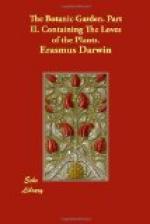“—She
never told her love;
But
let Concealment, like a worm i’ th’ bud,
Feed
on her damask cheek.”—
But in these lines below the person of Reason obtrudes itself into our company, and becomes disagreeable by its distinctness, and consequent improbability.
“To
Reason I flew, and intreated her aid,
Who
paused on my case, and each circumstance weigh’d;
Then
gravely reply’d in return to my prayer,
That
Hebe was fairest of all that were fair.
That’s
a truth, reply’d I, I’ve no need to be
taught,
I
came to you, Reason, to find out a fault.
If
that’s all, says Reason, return as you came,
To
find fault with Hebe would forfeit my name.”
Allegoric figures are on this account in general less manageable in painting and in statuary than in poetry: and can seldom be introduced in the two former arts in company with natural figures, as is evident from the ridiculous effect of many of the paintings of Rubens in the Luxemburgh gallery; and for this reason, because their improbability becomes more striking, when there are the figures of real persons by their side to compare them with. Mrs. Angelica Kauffman, well apprised of this circumstance, has introduced no mortal figures amongst her Cupids and her Graces. And the great Roubiliac, in his unrivalled monument of Time and Fame struggling for the trophy of General Fleming, has only hung up a medallion of the head of the hero of the piece. There are however some allegoric figures, which we have so often heard described or seen delineated, that we almost forget that they do not exist in common life; and hence view them without astonishment; as the figures of the heathen mythology, of angels, devils, death and time; and almost believe them to be realities, even when they are mixed with representations of the natural forms of man. Whence I conclude, that a certain degree of probability is necessary to prevent us from revolting with distaste from unnatural images; unless we are otherwise so much interested in the contemplation of them as not to perceive their improbability.
B. Is this reasoning about degrees of probability just?—When Sir Joshua Reynolds, who is unequalled both in the theory and practice of his art, and who is a great master of the pen as well as the pencil, has asserted in a discourse delivered to the Royal Academy, December 11, 1786, that “the higher styles of painting, like the higher kinds of the Drama, do not aim at any thing like deception; or have any expectation, that the spectators should think the events there represented are really passing before them.” And he then accuses Mr. Fielding of bad judgment, when he attempts to compliment Mr. Garrick in one of his novels, by introducing an ignorant man, mistaking the representation of a scene in Hamlet for a reality; and thinks, because he was an ignorant man, he was less liable to make such a mistake.




